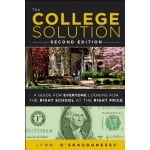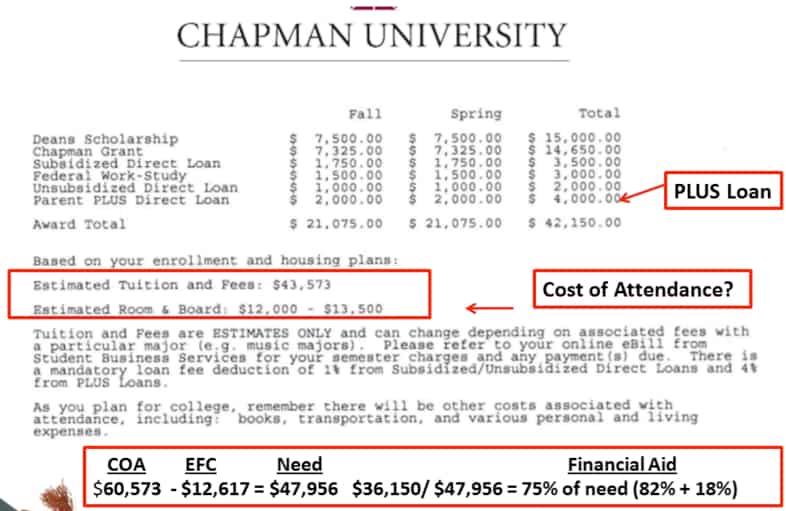
Many financial aid letters — heck almost all of them — are confusing.
I’ve always wondered why award letters are so difficult to understand. Perhaps the staffers generating these letters in the bowels of universities have been conversing in financial-aid speak for so long that they have lost their ability to communicate in standard English.
Of course, the cynical explanation for unhelpful financial aid awards is that many schools don’t want families to know when an offer is pathetic. Obfuscation is an effective way to keep parents off balance.
This week I got the opportunity to listen to a great webinar on deciphering financial aid letters that was sponsored by the National College Advocacy Group. The presenter was Paula Bishop, a CPA in Bellevue, WA, and a friend of mine, who has looked at hundreds of financial aid awards for her clients.
What Should Be in Every Financial Aid Award Letter
Here are the basic components that Bishop says should be in any financial aid letter:
- Full cost of attendance. This should be broken down into such expenses as tuition, room and board, textbooks, travel.
- Grant and scholarships. This money doesn’t have to be repaid.
- Types and amounts of loans. The loans should include the interest rates.
- Net amount student will have to pay after financial aid is deducted.
- Parent and student’s expected family contribution.
What was particularly helpful about the webinar is that Bishop shared examples of aid awards she has reviewed. I wanted to share one example today and I will provide more in my next college blog post.
Once you see actual award letters, you will have a better shot at understanding what your aid letters mean.
Chapman University
Today’s award letter comes from Chapman University in Orange County, CA, which has become a very hot school. As the school has grown more popular, the financial aid awards have gotten worse.
Take a good look. Does this appear to be a good award letter? Do you see anything missing from the award?
Oops. What’s Missing
At first glance, this might look like a generous award. It appears that the family will be getting $42,150. The letter, however, fails to include information that is necessary to know if this is a solid offer.
The letter doesn’t include Chapman’s full cost of attendance, which is a hefty $60,573. The letter provides the tuition/fees and estimated room/board of $12,000 to $13,500, but not books, travel and personal expenses. Some schools omit mentioning any costs including tuition!
The Chapman letter also doesn’t include what the family’s Expected Family Contribution is, which is a huge omission. The EFC is what a family, at a minimum, will have to pay to attend a school. If you need it, here is an EFC backgrounder:
What Is Your Expected Family Contribution?
You can’t determine if an award is good unless you know what your EFC, based on a financial aid formula, is.
This family’s EFC is $12,617. Ideally, the family would only have to pay $12,617 to attend any school. Realistically, however, most students will have to pay more than their EFC, but the closer to this figure the better. In this case, the family’s need was $47,956.
The Chapman award also included an item that schools should not be inserting in their packages, but typically do — the federal unsubsidized Stafford Loan, which in the letter is referred to as the Unsubsidized Direct Loan.
Any student can qualify for the unsubsidized Stafford Loan (interest rate 6.8%) and it hardly should be used by aid packagers to reduce a family’s obligation. The subsidized Stafford and the Perkins are more attractive loans that middle and lower-income families can qualify for so it’s legit for those to be in the package.
Chapman also inserted the Parent Plus Loan in the package ($4,000). Schools often put this loan in the package, but this is a misleading. The Parent PLUS Loan is a federal loan for parents with a 7.9% loan. And parents must pay an additional 4% for any amount that is borrowed.
Paula recently called Chapman’s financial aid office to ask why the PLUS Loan was included in this package and she was told that the school wanted the family to know about the existence of PLUS Loan. Gosh, I could think of a better way to tell parents about the PLUS. How about a supplemental sheet that lists loan possibilities along with interest rates?
Crunching the Numbers
When Paula removed the unsubsidized Stafford and PLUS loans, as well as work study from the package, the award dropped to $36,150. Remember, the student’s financial need is $47,956. Chapman met 75% of this student’s financial need and 18% of the package was in loans and a work-study job.
Botton Line:
This is not a good award for the girl who received it, but she might never have realized that without an expert’s help.
Unfortunately, you can’t count on many colleges and universities to provide a clear understanding of what they are offering in their aid awards. They are, after all, businesses.

More From The College Solution:
- The Nation’s Tuition Hogs
- Questions to Ask A Career Services Office
- Another Look At Merit Scholarships
- Where the Full-Ride Sports Scholarships Are



I work with families and recent college graduates in New York and agree with the prior posts in regard to the quality of information posted on this blog. That said, I am actually following up on your last comment Lynn as I am proud to report that SUNY has, indeed, agreed to standardize their financial aid award letters at all campuses to meet the new federal (suggested) guidelines. While I tend towards less government–particularly at the federal level–the finished product is, in my humble opinion, quite good. As is your blog, by the way!
— Patrick
Thanks for sharing Patrick. And thanks for your kind words!!
Lynn O’Shaughnessy
It would certainly help if there were a standard for conveying financial aid award information that included the items Lynn mentions. It would be even more helpful if the Net Price Calculators used the same standard. There is a HUD standard for mortgage closing statements and for many people financing a college education is second only to a mortgage. It is also hypocritical of colleges to require intimate details of your income and assets that allow them to understand everything about you without reciprocating such clarity of understanding in award letters.
Standrews — There is a standard financial aid document that the federal government has released, but many schools have shunned it so far. I will devote a blog post to this great tool later in the week.
Lynn O’Shaughnessy
Lynn,
How do you know from looking at this letter that “Subsidized Direct Loan” is actually an “unsubsidized Stafford loan”? Love the blog!
Angelo — Thanks for catching that mistake! I meant unsubsidized Stafford. I made the change after seeing your question.
I’m glad you love the blog!
Lynn O’Shaughnessy
Lynn,
Your Chapman example looks better than all of the ones my daughter has received. They have basically had only the top section from the Chapman example and I need to find the true costs for 2013-2014 on the school websites and plug the whole thing into a spreadsheet just to see what we are dealing with for the bottom line. I agree that this is a deceptive practice to make it look more attractive than it is. Why do you think the government doesn’t mandate a specific format for award letters?